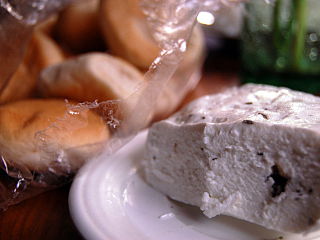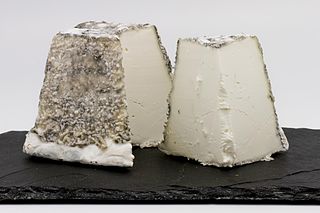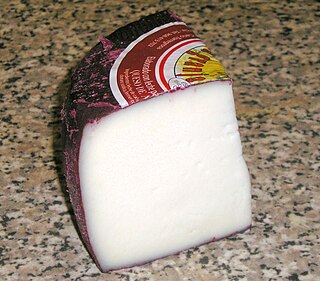This article needs additional citations for verification .(February 2008) |


Cheesecloth is a loose-woven gauze-like carded cotton cloth used primarily in cheesemaking and cooking. [1]
This article needs additional citations for verification .(February 2008) |


Cheesecloth is a loose-woven gauze-like carded cotton cloth used primarily in cheesemaking and cooking. [1]
Cheesecloth is available in at least seven different grades, from open to extra-fine weave. Grades are distinguished by the number of threads per inch in each direction. [2]
| Grade | Vertical × horizontal threads per inch | Vertical x horizontal threads/cm |
|---|---|---|
| #10 | 20 × 12 | 8 x 5 |
| #40 | 24 × 20 | 9.5 x 8 |
| #50 | 28 × 24 | 11 x 9.5 |
| #60 | 32 × 28 | 12.5 x 11 |
| #80 | 40 x 32 | |
| #90 | 44 × 36 | 17.5 x 14 |
| #100 | 54 x 46 | 21 x 18 |
The primary use of cheesecloth is in some styles of cheesemaking, where it is used to remove whey from cheese curds, and to help hold the curds together as the cheese is formed. Cheesecloth is also used in straining stocks and custards, bundling herbs, making tofu and ghee, and thickening yogurt. Queso blanco and queso fresco are Spanish and Mexican cheeses that are made from whole milk using cheesecloth. Italian Ricotta is made from cow, sheep or goat acidified whey, traditionally formed in cheesecloth cones. Quark is a type of German unsalted cheese that is sometimes formed with cheesecloth. Paneer is a kind of Indian fresh cheese that is commonly made with cheesecloth. Fruitcake is wrapped in rum-infused cheesecloth during the process of "feeding" the fruitcake as it ripens. [3]
Cheesecloth can also be used for several printmaking processes including lithography for wiping up gum arabic. In intaglio, a heavily-starched cheesecloth called tarlatan is used for wiping away excess ink from the printing surface. [4]
Cheesecloth #60 is used in product safety and regulatory testing for potential fire hazards. Cheesecloth is wrapped tightly over the device under test, which is then subjected to simulated conditions such as lightning surges conducted through power or telecom cables, power faults, etc. The device may be destroyed but must not ignite the cheesecloth. [5] This is to ensure that the device can fail safely, and not start electrical fires in the vicinity.
Cheesecloth made to United States Federal Standard CCC-C-440 is used to test the durability of optical coatings per United States Military Standard MIL-C-48497. The optics are exposed to a 95–100% humidity environment at 120 °F (49 °C) for 24 hours, and then a 1⁄4 inch (6.4 mm) thick by 3⁄8 in (9.5 mm) wide pad of cheesecloth is rubbed over the optical surface for at least 50 strokes under at least 1 pound-force (4.4 N). The optical surface is examined for streaks or scratches, and then its optical performance is measured to ensure that no deterioration occurred. [6]
Cheesecloth is used in India and Pakistan for making summer shirts. Cheesecloth material shirts were popular for beachwear during the 1960s and 1970s in the United States. [7] Cheesecloth has been used to create the illusion of "ectoplasm" during spirit channelling or other ghost-related phenomena. [8] [9]
Cheesecloth has a use in anatomical dissection laboratories to slow the process of desiccation. The cloth can be soaked with a preservative solution such as formalin then wrapped around the specimen or at other times simply wrapped first then sprayed with water. [10]

Curd is obtained by coagulating milk in a sequential process called curdling. It can be a final dairy product or the first stage in cheesemaking. The coagulation can be caused by adding rennet, a culture, or any edible acidic substance such as lemon juice or vinegar, and then allowing it to coagulate. The increased acidity causes the milk proteins (casein) to tangle into solid masses, or curds. Milk that has been left to sour will also naturally produce curds, and sour milk cheeses are produced this way.

Goat cheese, goat's cheese or chèvre is cheese made from goat's milk. Goats were among the first animals to be domesticated for producing food. Goat cheese is made around the world with a variety of recipes, giving many different styles of cheeses, from fresh and soft to aged and hard.

Colby is a semihard orange cheese made from cow's milk. It is named after the city of Colby, Wisconsin, USA, where it was first developed in 1885 and quickly became popular.

Cheesemaking is the craft of making cheese. The production of cheese, like many other food preservation processes, allows the nutritional and economic value of a food material, in this case milk, to be preserved in concentrated form. Cheesemaking allows the production of the cheese with diverse flavors and consistencies.
Hoop cheese is a traditional cow's milk cheese that was common in the Southern United States from the early to mid 1900s. It is still available today, although it is much less common. It is a simple cheese prepared by separating the whey from curds. Today, the American Dairy Association has no criteria in place to classify hoop cheese, although it has sometimes been referred to as a type of pot cheese.

Paneer, also known as ponir, is a fresh acid-set cheese common in the cuisine of the Indian subcontinent made from full-fat buffalo milk or cow milk. It is a non-aged, non-melting soft cheese made by curdling milk with a fruit- or vegetable-derived acid, such as lemon juice.

Acid-set or sour milk cheese is cheese that has been curdled (coagulated) by natural souring, often from lactic acid bacteria, or by the addition of acid. This type of cheese is technologically simple to produce.
Crowdie is a type of soft, fresh cheese made from cows' milk, traditionally from Scotland.
White cheese includes a wide variety of cheese types discovered in different regions, sharing the sole common characteristic of their white hue. The specific type of white cheese can vary significantly depending on the geographical location.

Cheese is a dairy product produced in a range of flavors, textures, and forms by coagulation of the milk protein casein. It comprises proteins and fat from milk. During production, milk is usually acidified and either the enzymes of rennet or bacterial enzymes with similar activity are added to cause the casein to coagulate. The solid curds are then separated from the liquid whey and pressed into finished cheese. Some cheeses have aromatic molds on the rind, the outer layer, or throughout.

Kesong puti is a Filipino soft, unaged, white cheese made from unskimmed carabao milk and salt curdled with vinegar, citrus juices, or sometimes rennet. It can also be made with goat or cow milk. It has a mild salty and tart flavor. When an acidifying agent is used, it resembles queso blanco or paneer. When rennet is used, it resembles buffalo mozzarella. Moisture content can also vary, ranging from almost gelatinous to pressed and firm. It can be eaten as is, paired with bread, or used in various dishes in Filipino cuisine. It is usually sold wrapped in banana leaves.

Caprino is an Italian cheese traditionally made from whole or skimmed goat's milk. The name of the cheese derives from the Italian word for goat, capra. With modern methods of production, the cheese is made from cow's milk as well or a combination of both cow's and goat's milks. The two major styles of caprino are fresco ("fresh") and stagionato ("aged").

There are many different types of cheese. Cheeses can be grouped or classified according to criteria such as length of fermentation, texture, methods of production, fat content, animal milk, and country or region of origin. The method most commonly and traditionally used is based on moisture content, which is then further narrowed down by fat content and curing or ripening methods. The criteria may either be used singly or in combination, with no single method being universally used.

Paraguay cheese is a cows' milk cheese from Paraguay. It gives the Paraguayan cuisine a high value in calories and proteins, especially in the salted dishes recipes, very characteristic of the country and an important part of its culture.

Cheeses in Mexico have a history that begins with the Spanish conquest, as dairy products were unknown in pre-Columbian Mesoamerica. The Spanish brought dairy animals, such as cattle, sheep, and goats, as well as cheesemaking techniques. Over the colonial period, cheesemaking was modified to suit the mixed European and indigenous tastes of the inhabitants of New Spain, varying by region. This blending and variations have given rise to a number of varieties of Mexican cheeses. These are most popular in the country, although European cheeses are made, as well. Almost all cheese in Mexico is made with cows’ milk, with some made from goats’ milk. More recently, efforts have been made to promote sheep's milk cheeses. Most cheeses are made with raw (unpasteurized) milk. Cheeses are made in the home, on small farms or ranches, and by major dairy product firms. Between 20 and 40 different varieties of cheese are made in Mexico, depending on how one classifies them. Some, such as Oaxaca and panela, are made all over Mexico, but many are regional cheeses known only in certain sections on the country. Some of the least common are in danger of extinction.
Alpujarras cheese is a Spanish cheese from the eastern region of Andalusia, which includes the provinces of Granada, Almería and the Penibética mountain chain. The cheese takes its name from La Alpujarra, a mountainous region which occupies a part of southern Granada province and western Almeria province. This area has a long history and tradition of goatherding. Alpujarras cheese is made from the milk of the White Andalusian domesticated goat.

Casín cheese is a Spanish cheese made in the Principality of Asturias. Its name is covered by a protected designation of origin (PDO). It is made from full-fat, unpasteurized cows' milk from specific breeds, namely Asturian Mountain, Asturian Valley (Asturiana de la Valles), Friesian and any crosses between these breeds. Specifically the geographic area of manufacture is the southern part of Asturias which includes the Redes Natural Park and associated land, this is within the municipalities of Caso, Sobrescobio and Piloña. The cheese is classified as hard and semi-hard, and can be semi-cured or cured. It takes its name from one of the breeds of cattle whose milk is used, in turn named after the town of Caso. The shape of the cheese is a thick disc-shape, sometime more conical, of 10–20 cm diameter and 4–7 cm in height. The weight is between 250 and 1,000 g.

Murcian wine cheese is a fatty goats’ milk cheese from the province of Murcia in the south-east of Spain. It has a Protected Designation of Origin. The cheese is made only from unpasteurized goats’ milk of the Murcian breed from registered herds. The term al vino refers to the washing of the rind with red wine during maturation. The cheese is presented in cylinders 6–7 cm (2-3 inches) high and 7–9 cm (3-4 inches) diameter weighing 400 g, or 7–9 cm (3-4 inches) high and 12–18 cm (5-7 inches) diameter weighing 1 kg (2.2 lbs) or 2 kg (4.4 lbs).

Tulum cheese is a traditional Turkish goat's milk cheese ripened in a goatskin casing, called tulum in Turkish.

Swiss-type cheeses, also known as Alpine cheeses, are a group of hard or semi-hard cheeses with a distinct character, whose origins lie in the Alps of Europe, although they are now eaten and imitated in most cheesemaking parts of the world. Their distinct character arose from the requirements of cheese made in the summer on high Alpine grasslands, and then transported with the cows down to the valleys in the winter, in the historic culture of Alpine transhumance. Traditionally the cheeses were made in large rounds or "wheels" with a hard rind, and were robust enough for both keeping and transporting.